KnowledgeBase
On this page, you find all documents, package deals, and flashcards offered by seller KnowledgeBase.
- 3981
- 0
- 631
Community
- Followers
- Following
172 Reviews received
4629 items
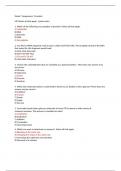
CHEM 120 Week 7 Assignment; Biochemistry Part 2 and Flow of Genetic Information (15 Points)
MC/Select all that apply: 1 point each) 1. Which of the following are examples of proteins? Select all that apply. A) Antibodies B) DNA C) Enzymes D) RNA E) Hemoglobin 2. You find a mRNA fragment reads in part as AAU-UUA-GAU-UAA. The template strand of the DNA that coded for this fragment would read: A) AAU-UUA-GAU-UAA B) AAT-TTA-GAT-TAA C) TTA-AAT-CTA-ATT D) UUA-AAU-CUA-AUU 3. Choose the carbohydrates that are classified as a polysaccharides. More than one answer may be correc...
- Package deal
- Other
- • 3 pages •
MC/Select all that apply: 1 point each) 1. Which of the following are examples of proteins? Select all that apply. A) Antibodies B) DNA C) Enzymes D) RNA E) Hemoglobin 2. You find a mRNA fragment reads in part as AAU-UUA-GAU-UAA. The template strand of the DNA that coded for this fragment would read: A) AAU-UUA-GAU-UAA B) AAT-TTA-GAT-TAA C) TTA-AAT-CTA-ATT D) UUA-AAU-CUA-AUU 3. Choose the carbohydrates that are classified as a polysaccharides. More than one answer may be correc...
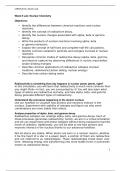
CHEM 120 Week 6 Virtual Lab; Nuclear Chemistry.
Week 6 Lab: Nuclear Chemistry Objectives: • Identify the differences between chemical reactions and nuclear reactions. • Identify the concept of radioactive decay. • Identify the nuclear changes associated with alpha, beta or gamma decay. • Write the products of nuclear reactions involving alpha, beta or gamma emissions. • Explain the concept of half-lives and complete half-life calculations. • Identify common subatomic particles and energies involved in nuclear reactions • ...
- Package deal
- Other
- • 11 pages •
Week 6 Lab: Nuclear Chemistry Objectives: • Identify the differences between chemical reactions and nuclear reactions. • Identify the concept of radioactive decay. • Identify the nuclear changes associated with alpha, beta or gamma decay. • Write the products of nuclear reactions involving alpha, beta or gamma emissions. • Explain the concept of half-lives and complete half-life calculations. • Identify common subatomic particles and energies involved in nuclear reactions • ...
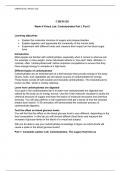
CHEM 120 Week 6 Virtual Lab; Carbohydrates Part I, Part II
Learning objectives • Explain the molecular structure of sugars and polysaccharides • Explain digestion and appreciate the complexity of the human body • Experiment with different foods and measure their impact on the blood sugar level Introduction Most people are familiar with carbohydrates, especially when it comes to what we eat. For example, to lose weight, some individuals adhere to “low-carb” diets. Athletes, in contrast, often “carbohydrate-load” before important compet...
- Package deal
- Other
- • 3 pages •
Learning objectives • Explain the molecular structure of sugars and polysaccharides • Explain digestion and appreciate the complexity of the human body • Experiment with different foods and measure their impact on the blood sugar level Introduction Most people are familiar with carbohydrates, especially when it comes to what we eat. For example, to lose weight, some individuals adhere to “low-carb” diets. Athletes, in contrast, often “carbohydrate-load” before important compet...
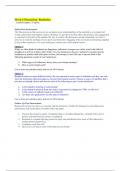
CHEM 120 Week 6 Discussion; Radiation (Option 2; Topic of Uranium-238)
Initial Post Instructions The Discussions in this course are set up deepen your understanding of the material as you make real world connections and employ creative thinking. To get the most from these discussions, full engagement is expected on the part of the student. Be sure to stop by the discussion section frequently, not only to post, but to read the postings of your peers and instructor. Engaging with your peers and learning together is key to this experience. For your initial post, choo...
- Package deal
- Other
- • 2 pages •
Initial Post Instructions The Discussions in this course are set up deepen your understanding of the material as you make real world connections and employ creative thinking. To get the most from these discussions, full engagement is expected on the part of the student. Be sure to stop by the discussion section frequently, not only to post, but to read the postings of your peers and instructor. Engaging with your peers and learning together is key to this experience. For your initial post, choo...

CHEM 120 Week 6 Discussion; Radiation (Option 1; Radioisotope Tc-99m)
Initial Post Instructions The Discussions in this course are set up deepen your understanding of the material as you make real world connections and employ creative thinking. To get the most from these discussions, full engagement is expected on the part of the student. Be sure to stop by the discussion section frequently, not only to post, but to read the postings of your peers and instructor. Engaging with your peers and learning together is key to this experience. For your initial post, choo...
- Package deal
- Other
- • 2 pages •
Initial Post Instructions The Discussions in this course are set up deepen your understanding of the material as you make real world connections and employ creative thinking. To get the most from these discussions, full engagement is expected on the part of the student. Be sure to stop by the discussion section frequently, not only to post, but to read the postings of your peers and instructor. Engaging with your peers and learning together is key to this experience. For your initial post, choo...
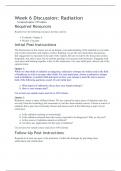
CHEM 120 Week 6 Discussion; Radiation (Option 1; Radioactive Isotope; Cobalt-60)
Option 1: While we often think of radiation as dangerous, radioactive isotopes are widely used in the field of healthcare as well as in many other fields. For your initial post, choose a radioactive isotope used in healthcare or another field and report on how your isotope is used. Be sure to answer both of the following questions as part of your initial post: a. What type(s) of radioactive decay does your isotope undergo? b. How is your isotope used? Use at least one outside source and ci...
- Package deal
- Other
- • 4 pages •
Option 1: While we often think of radiation as dangerous, radioactive isotopes are widely used in the field of healthcare as well as in many other fields. For your initial post, choose a radioactive isotope used in healthcare or another field and report on how your isotope is used. Be sure to answer both of the following questions as part of your initial post: a. What type(s) of radioactive decay does your isotope undergo? b. How is your isotope used? Use at least one outside source and ci...
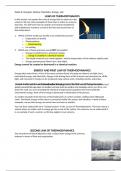
CHEM 120 Week 6 Concepts; Nuclear Chemistry, Energy, and Biochemistry Part 1
In this section, we explore the rules of energy that we observe in the universe. We see many examples of these laws in action on a day-to- day basis. You will learn how to compare and contrast exothermic and endothermic reactions as well as the first and second laws of thermodynamics.
- Package deal
- Other
- • 34 pages •
In this section, we explore the rules of energy that we observe in the universe. We see many examples of these laws in action on a day-to- day basis. You will learn how to compare and contrast exothermic and endothermic reactions as well as the first and second laws of thermodynamics.
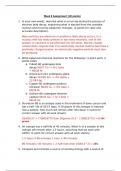
CHEM 120 Week 6 Assignment; Energy, Nuclear Chemistry, (20 points)
1. In your own words, describe what is occurring during the process of electron beta decay, explaining what is ejected from the unstable nucleus and focusing subatomic changes. (2 points for clear and accurate description). 2. Write balanced chemical reactions for the following: (1 point each, 4 points total) a. Cobolt-60 undergoes beta decay b. Americium-241 undergoes alpha decay c. Copper-60 undergoes positron emission d. Gallium-66 undergoes electron capture 3. Strontium-89 is an is...
- Package deal
- Other
- • 4 pages •
1. In your own words, describe what is occurring during the process of electron beta decay, explaining what is ejected from the unstable nucleus and focusing subatomic changes. (2 points for clear and accurate description). 2. Write balanced chemical reactions for the following: (1 point each, 4 points total) a. Cobolt-60 undergoes beta decay b. Americium-241 undergoes alpha decay c. Copper-60 undergoes positron emission d. Gallium-66 undergoes electron capture 3. Strontium-89 is an is...
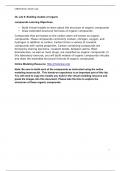
CHEM 120 Week 5 Virtual Lab; Organic Chemistry
OL Lab 9: Building models of organic compounds Learning Objectives: • Build virtual models to learn about the structure of organic compounds • Draw extended structural formulas of organic compounds Compounds that are based on the carbon atom are known as organic compounds. These compounds commonly contain, nitrogen, oxygen, and hydrogen in addition to carbon. Carbon forms a variety of covalent compounds with varied properties. Carbon containing compounds are formed by sharing electrons, c...
- Package deal
- Other
- • 15 pages •
OL Lab 9: Building models of organic compounds Learning Objectives: • Build virtual models to learn about the structure of organic compounds • Draw extended structural formulas of organic compounds Compounds that are based on the carbon atom are known as organic compounds. These compounds commonly contain, nitrogen, oxygen, and hydrogen in addition to carbon. Carbon forms a variety of covalent compounds with varied properties. Carbon containing compounds are formed by sharing electrons, c...
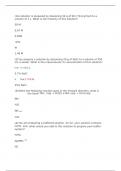
CHEM 120 Week 5 Exam 2 (Units 3 and 4)
1. A solution is prepared by dissolving 50 g of KCl (74.6 g/mol) to a volume of 1 L. What is the molarity of this solution? 2. You prepare a solution by dissolving 20 g of NaCl to a volume of 350 mL in water. What is the mass/volume % concentration of this solution? 3. When the following reaction goes in the forward direction, what is the base? 4. You are preparing a buffered solution. So far, your solution contains H2PO4- ions, what would you add to this solution to prepare your buffer sy...
- Package deal
- Exam (elaborations)
- • 14 pages •
1. A solution is prepared by dissolving 50 g of KCl (74.6 g/mol) to a volume of 1 L. What is the molarity of this solution? 2. You prepare a solution by dissolving 20 g of NaCl to a volume of 350 mL in water. What is the mass/volume % concentration of this solution? 3. When the following reaction goes in the forward direction, what is the base? 4. You are preparing a buffered solution. So far, your solution contains H2PO4- ions, what would you add to this solution to prepare your buffer sy...

NRNP 6531 Week 10 Knowledge Check; Musculoskeletal Conditions and Neurologic Conditions (Summer 2021).docx
BIO 220 Topic 1 Quiz
MATH 534 Week 7 Course Project, Final Part C; Regression and Correlation Analysis
NURS 6002 Week 3 Assignment; Part 3 - Strategies to Promote Integrity and Professional Ethics
NR 631 Week 6 Discussion; Planning and Scheduling (Initial Post, Responses)